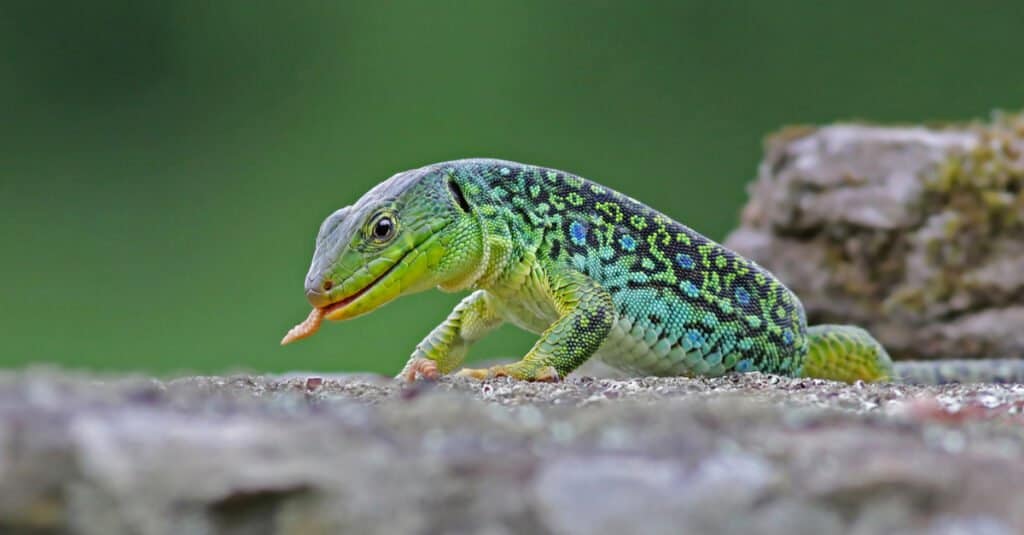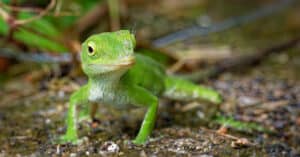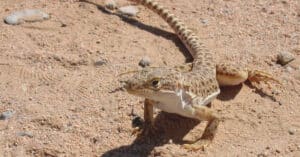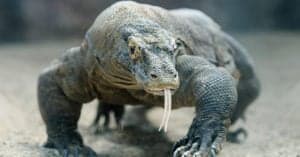10 Types Of Amazing Green Lizards
Around 4,675 lizard species exist, with new species always being discovered. In this article, you will learn about 10 types of green lizard species, and how amazing these reptiles can be. A lizard’s color is one of its most important traits and uses it to survive in the wild. Its color helps it camouflage into its habitat and better hide from predators such as birds, snakes, or large mammals. Green is one of the most common colors, but it does not end there. Even common lizards that you may come across in your backyard may be able to change their color to better blend into their habitat.
Let’s go over 10 types of green lizards that you may enjoy learning about. Green is one of the most well-known colors that a lizard can appear in, but many are able to change their shade like a chameleon. Chameleons are able to change their shade by manipulating a layer of cells to affect how light reflects off their body. Mood, temperature, and habitat all play a role in a lizard’s color. Here are 10 types of green lizards, and interesting things you should know about each one.
1. Mexican Alligator Lizard
Because they resemble an alligator, Abronia graminea is named the Mexican alligator lizard. This lizard is covered in bright green scales and has sharp claws. They are arboreal and have rigid scales that blend in with trees. The underside of this species is bright yellow, and they have a long tail with strong limbs.
Mexican alligator lizards are an endangered species, native to a small region in Mexico found in the Sierra Madre Oriental mountain range. The pet trade has been the main cause for this species’ natural decline since they are captured in the wild to be sold. Most of the species that are kept as pets are captive-bred and purchased for a large sum since they are so rare.
2. Caiman Lizard
Caiman lizards (Dracaena guianensis) are easily recognizable because of their coloring. Their head is red, and the rest of this species body is green. They are a large species, regularly reaching between 2 to 4 feet long, and weighing up to 10 pounds. Caiman lizards are covered in short horn-like scales and have sharp claws helpful for climbing. Their jaws are powerful but more beneficial in crushing prey like snails.
Caiman lizards are native to South America and live in flooded woodlands. They are semi-aquatic and also great climbers. Their heavy bodies and sharp claws make them look similar to a tegu lizard, but they are cousins of this lizard. In their native range, they are hunted for their meat and eaten but kept as pets in other areas of the world.
3. Jeweled Gecko

reptiles4all/Shutterstock.com
Native to the South Island of New Zealand, the jeweled gecko (Naultinus gemmeus) is an endangered species, and rare to come across. Habitat destruction and invasive species are the main reason this gecko has become endangered. Shrublands, wooded areas, and drylands are the habitats they can be found in. Jeweled Geckos are active in the day and spend most of their time in trees.
Jeweled geckos are bright green with a pattern of stripes or diamonds on their back. Their underside is usually white or yellow-colored. On average they grow to be around 7 inches, with most of their length being their tail.
4. Green Water Dragon
Green water dragons are also called the Chinese water dragon and are native to southeast Asia. They are semi-aquatic lizards that spend their time near the edges of fresh waterways. This species is kept a pet due to its beautiful colors, and cool look. Like most lizards, a captive-bred Green water dragon is best for keeping as a pet.
Green to dark green are the colors this species is found in. They grow to be around 2.9 feet and can live for more than a decade. These lizards are great swimmers and can hold their breath while they travel through the water.
5. Jeweled Lacerta

Fercast/Shutterstock.com
Jeweled Lacertas (Timon lepidus) are beautifully colored green lizards, with blue eyes and a rosette pattern covering them. This lizard is capable of reaching up to 2 feet long but does not weigh as much as other lizards its size. Meadows, woodlands, and sandy areas are where this species can be found. They are active during the day and are primarily found in Europe.
Jeweled Lacertas are not a popular pet species but can be a great reptile companion for the right person. They are less popular than other reptile species to keep, only because this lizard is not commonly known about. They are food motivated and feed on whatever insects that they can find. When cared for properly they can live around 12 to 20 years.
6. Jackson’s Chameleon
The Jackson’s Chameleon (Trioceros jacksonii) is just one of the 150 chameleon species found in the world. It is also called the Kikuyu three-horned chameleon, because of the rhinoceros-like horns that protrude from its head. Jackson’s chameleons are naive to Africa in Kenya and northern Tanzania. They have a small population in the U.S. and other countries due to the pet trade.
Three brown horns protrude from the males of this species head, but females will usually lack this trait. The average male grows to be around 15 inches, while females usually reach 10 inches. Green is the most common color for this species, but they are able to change their color like other chameleons. A chameleon changes its color based on its mood, temperature, and health.
7. Madagascar Giant Day Gecko
Native to Madagascar, the Madagascar giant day gecko ( Phelsuma grandis) is a lizard that spends most of its time in the canopy of trees. These geckos are bright green which helps them camouflage in their habitat. They are a large species able to group up to 10 inches. A red mottled pattern can be seen sometimes on their head and sides.
Madagascan Giant day geckos are active during the day, and their bright coloring makes them popular pets. This gecko survives on an omnivorous diet and has a quick speed that is helpful in catching insects.
8. Plumed Basilisk
With a dinosaur-like appearance and bright green coloring, the Plumed Basilisk (Basiliscus plumifrons) is one of the most unique species of lizards in the world. They are also called the Jesus Christ Lizard since juveniles are able to run across the water like it is solid land. Their special feet make them able to run on water by quickly slapping the ground. As they become full-grown they lose this ability.
Males of this species have a crest on their head, back and tail, but females only have a crest on their head. This basilisk lizard is the only type of basilisk that is bright green, and they also have round yellow eyes. Green Basilisks are native to the tropical regions of Honduras, Nicaragua, Panama, and Costa Rica.
9. Green Anole
Green anoles (Anolis carolinensis) are native to the southeastern United States, found in states like Florida, and North Carolina. They are also a common species to come across in urban and suburban areas. Trees, shrubs and other vegetation is where this species prefers to be since they are arboreal.
Green anoles have bright green coloring to help them blend into the environment they live in. Some can also be shades of gray or brown. On males, this lizard will have a dewlap hanging from their neck, rarely seen on females. In Hawaii, Japan, and other areas of the world this lizard has managed to build a population in the wild.
10. Green Iguana
Green Iguanas (Iguana iguana) are an arboreal species, native to the tropical regions of Central America, South America, and the Caribbean Islands. Now they are found all over the world, including Florida where they’ve become an invasive species. Green iguanas are the largest iguanas species of iguana on earth, capable of growing up to 5.6 feet long. The largest males can weigh up to 8 pounds.
This species is known and named after its green coloring. Some of these lizards are yellow, bright green, and sometimes gray. They have a prehistoric look with spines on their back, and sharp teeth used for shredding vegetation. They have mild venom that is harmless to humans, but a bite from this species can be painful. Albino Iguanas are extremely expensive but are less aggressive since they have very poor eyesight.
More from A-Z Animals
Around 4,675 lizard species exist, with new species always being discovered. In this article, you will learn about 10 types of green lizard species, and how amazing these reptiles can be. A lizard’s color is one of its most important traits and uses it to survive in the wild. Its color helps it camouflage into its habitat and better hide from predators such as birds, snakes, or large mammals. Green is one of the most common colors, but it does not end there. Even common lizards that you may come across in your backyard may be able to change their color to better blend into their habitat.
Let’s go over 10 types of green lizards that you may enjoy learning about. Green is one of the most well-known colors that a lizard can appear in, but many are able to change their shade like a chameleon. Chameleons are able to change their shade by manipulating a layer of cells to affect how light reflects off their body. Mood, temperature, and habitat all play a role in a lizard’s color. Here are 10 types of green lizards, and interesting things you should know about each one.
1. Mexican Alligator Lizard
Because they resemble an alligator, Abronia graminea is named the Mexican alligator lizard. This lizard is covered in bright green scales and has sharp claws. They are arboreal and have rigid scales that blend in with trees. The underside of this species is bright yellow, and they have a long tail with strong limbs.
Mexican alligator lizards are an endangered species, native to a small region in Mexico found in the Sierra Madre Oriental mountain range. The pet trade has been the main cause for this species’ natural decline since they are captured in the wild to be sold. Most of the species that are kept as pets are captive-bred and purchased for a large sum since they are so rare.
2. Caiman Lizard
Caiman lizards (Dracaena guianensis) are easily recognizable because of their coloring. Their head is red, and the rest of this species body is green. They are a large species, regularly reaching between 2 to 4 feet long, and weighing up to 10 pounds. Caiman lizards are covered in short horn-like scales and have sharp claws helpful for climbing. Their jaws are powerful but more beneficial in crushing prey like snails.
Caiman lizards are native to South America and live in flooded woodlands. They are semi-aquatic and also great climbers. Their heavy bodies and sharp claws make them look similar to a tegu lizard, but they are cousins of this lizard. In their native range, they are hunted for their meat and eaten but kept as pets in other areas of the world.
3. Jeweled Gecko

reptiles4all/Shutterstock.com
Native to the South Island of New Zealand, the jeweled gecko (Naultinus gemmeus) is an endangered species, and rare to come across. Habitat destruction and invasive species are the main reason this gecko has become endangered. Shrublands, wooded areas, and drylands are the habitats they can be found in. Jeweled Geckos are active in the day and spend most of their time in trees.
Jeweled geckos are bright green with a pattern of stripes or diamonds on their back. Their underside is usually white or yellow-colored. On average they grow to be around 7 inches, with most of their length being their tail.
4. Green Water Dragon
Green water dragons are also called the Chinese water dragon and are native to southeast Asia. They are semi-aquatic lizards that spend their time near the edges of fresh waterways. This species is kept a pet due to its beautiful colors, and cool look. Like most lizards, a captive-bred Green water dragon is best for keeping as a pet.
Green to dark green are the colors this species is found in. They grow to be around 2.9 feet and can live for more than a decade. These lizards are great swimmers and can hold their breath while they travel through the water.
5. Jeweled Lacerta

Fercast/Shutterstock.com
Jeweled Lacertas (Timon lepidus) are beautifully colored green lizards, with blue eyes and a rosette pattern covering them. This lizard is capable of reaching up to 2 feet long but does not weigh as much as other lizards its size. Meadows, woodlands, and sandy areas are where this species can be found. They are active during the day and are primarily found in Europe.
Jeweled Lacertas are not a popular pet species but can be a great reptile companion for the right person. They are less popular than other reptile species to keep, only because this lizard is not commonly known about. They are food motivated and feed on whatever insects that they can find. When cared for properly they can live around 12 to 20 years.
6. Jackson’s Chameleon
The Jackson’s Chameleon (Trioceros jacksonii) is just one of the 150 chameleon species found in the world. It is also called the Kikuyu three-horned chameleon, because of the rhinoceros-like horns that protrude from its head. Jackson’s chameleons are naive to Africa in Kenya and northern Tanzania. They have a small population in the U.S. and other countries due to the pet trade.
Three brown horns protrude from the males of this species head, but females will usually lack this trait. The average male grows to be around 15 inches, while females usually reach 10 inches. Green is the most common color for this species, but they are able to change their color like other chameleons. A chameleon changes its color based on its mood, temperature, and health.
7. Madagascar Giant Day Gecko
Native to Madagascar, the Madagascar giant day gecko ( Phelsuma grandis) is a lizard that spends most of its time in the canopy of trees. These geckos are bright green which helps them camouflage in their habitat. They are a large species able to group up to 10 inches. A red mottled pattern can be seen sometimes on their head and sides.
Madagascan Giant day geckos are active during the day, and their bright coloring makes them popular pets. This gecko survives on an omnivorous diet and has a quick speed that is helpful in catching insects.
8. Plumed Basilisk
With a dinosaur-like appearance and bright green coloring, the Plumed Basilisk (Basiliscus plumifrons) is one of the most unique species of lizards in the world. They are also called the Jesus Christ Lizard since juveniles are able to run across the water like it is solid land. Their special feet make them able to run on water by quickly slapping the ground. As they become full-grown they lose this ability.
Males of this species have a crest on their head, back and tail, but females only have a crest on their head. This basilisk lizard is the only type of basilisk that is bright green, and they also have round yellow eyes. Green Basilisks are native to the tropical regions of Honduras, Nicaragua, Panama, and Costa Rica.
9. Green Anole
Green anoles (Anolis carolinensis) are native to the southeastern United States, found in states like Florida, and North Carolina. They are also a common species to come across in urban and suburban areas. Trees, shrubs and other vegetation is where this species prefers to be since they are arboreal.
Green anoles have bright green coloring to help them blend into the environment they live in. Some can also be shades of gray or brown. On males, this lizard will have a dewlap hanging from their neck, rarely seen on females. In Hawaii, Japan, and other areas of the world this lizard has managed to build a population in the wild.
10. Green Iguana
Green Iguanas (Iguana iguana) are an arboreal species, native to the tropical regions of Central America, South America, and the Caribbean Islands. Now they are found all over the world, including Florida where they’ve become an invasive species. Green iguanas are the largest iguanas species of iguana on earth, capable of growing up to 5.6 feet long. The largest males can weigh up to 8 pounds.
This species is known and named after its green coloring. Some of these lizards are yellow, bright green, and sometimes gray. They have a prehistoric look with spines on their back, and sharp teeth used for shredding vegetation. They have mild venom that is harmless to humans, but a bite from this species can be painful. Albino Iguanas are extremely expensive but are less aggressive since they have very poor eyesight.







